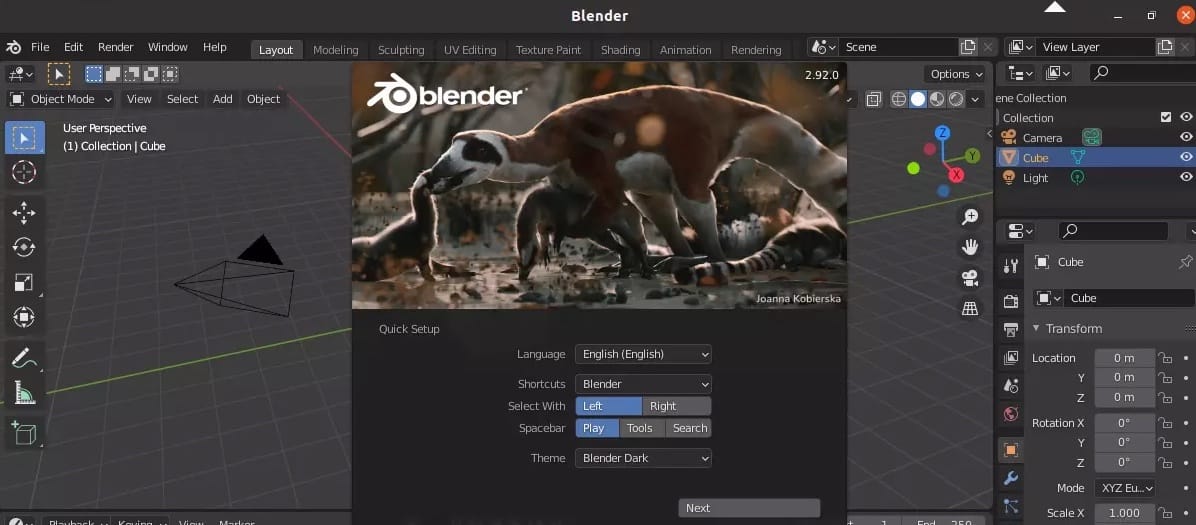How To Install Blender on openSUSE

In this tutorial, we will show you how to install Blender on openSUSE. Blender stands as one of the most powerful open-source 3D creation suites available today, offering a comprehensive set of tools for modeling, animation, rendering, and much more. For openSUSE Linux users looking to dive into 3D design, animation, or game development, installing Blender properly ensures you’ll have a smooth experience with this feature-rich application. This comprehensive guide walks you through various installation methods on openSUSE, from simple package manager installations to more advanced approaches, ensuring you can choose the method that best fits your needs.
Understanding Blender and System Requirements
Before diving into installation procedures, it’s important to understand what Blender is and what your system needs to run it effectively.
What is Blender?
Blender is a free and open-source 3D creation suite that supports the entirety of the 3D pipeline—modeling, rigging, animation, simulation, rendering, compositing, motion tracking, and video editing. Its versatility makes it popular among professional artists, hobbyists, game developers, and animators worldwide.
System Requirements for Blender on openSUSE
To run Blender smoothly on openSUSE, your system should meet these minimum requirements:
- 64-bit dual-core CPU (quad-core recommended)
- 4GB RAM (8GB or more recommended for complex projects)
- OpenGL 3.3-compatible graphics card with 1GB RAM
- Three-button mouse or stylus/tablet for optimal control
- Internet connection for updates and add-ons
Blender will run on both openSUSE Leap (stable release) and Tumbleweed (rolling release), but the installation process differs slightly between them. Tumbleweed users typically have access to more recent Blender versions through the official repositories.
Preparing Your System
Before installation, it’s advisable to:
- Check your current hardware specifications using the command:
inxi -Fxxxz - Verify your graphics drivers are up-to-date, especially important for 3D work:
sudo zypper update - Ensure you have sufficient disk space (at least 1GB for Blender and its dependencies)
Pre-Installation Steps
Taking a few preparatory steps before installing Blender will ensure a smooth installation process.
Update Your System
First, make sure your openSUSE system is fully updated. Open a terminal and run:
sudo zypper ref
sudo zypper updateThis refreshes your repository data and updates all packages on your system. Keeping your system updated minimizes potential dependency issues and ensures compatibility with newly installed software.
Check for Dependencies
Blender relies on several libraries and packages to function correctly. Most installation methods will handle dependencies automatically, but it’s helpful to understand that Blender requires Python, OpenGL libraries, and multimedia codecs to function properly.
Backup Considerations
If you’re upgrading from an existing Blender installation, consider backing up your user preferences and add-ons:
cp -r ~/.config/blender ~/blender-config-backupThis simple step can save you considerable time if you need to restore your customized settings later.
Installation Method 1: Using Package Manager
The simplest and most straightforward method for installing Blender on openSUSE is through the default package manager. This approach ensures system integration and simplifies future updates.
Benefits of Package Manager Installation
Using the package manager (zypper) for installation offers several advantages:
- Automatic dependency resolution
- Integration with system updates
- Easy uninstallation process
- Consistency with other system packages
Installing from Official Repositories Using YaST
YaST provides a graphical interface for package management:
- Open YaST Software Manager from the application menu or run:
sudo yast2 sw_single - Search for “blender” in the search box
- Mark the blender package for installation
- Click “Accept” to install Blender and its dependencies
Command Line Installation with Zypper
For terminal enthusiasts, zypper provides a powerful command-line alternative:
- First, search for the Blender package:
zypper se blender - Install Blender using:
sudo zypper install blender - Verify the installation was successful:
blender --version
This command should display the installed Blender version number and build information.
Version Considerations
The version available in the official repositories may not be the latest release. For openSUSE Leap, the repositories typically contain a stable but possibly older version of Blender. Tumbleweed users generally have access to more recent versions. If you need the very latest features, consider the alternative installation methods described below.
Installation Method 2: Using Additional Repositories
When you need a newer version of Blender than what’s available in the standard repositories, additional repositories can provide access to more current releases.
Understanding openSUSE Repositories
openSUSE uses a repository system that allows different sources for software packages. Besides the official repositories, there are community-maintained repositories that often provide more recent software versions.
Adding the Graphics Repository
The Graphics repository contains more up-to-date versions of graphic applications, including Blender:
For Tumbleweed:
sudo zypper addrepo https://download.opensuse.org/repositories/graphics/openSUSE_Tumbleweed/graphics.repo
sudo zypper refresh
sudo zypper install blenderFor Leap:
sudo zypper addrepo https://download.opensuse.org/repositories/graphics/openSUSE_Leap_$version/graphics.repo
sudo zypper refresh
sudo zypper install blenderReplace $version with your Leap version (e.g., 15.5).
Using the Blender Git Repository for Tumbleweed
For Tumbleweed users, there’s a community repository that provides builds directly from Blender’s development branch:
sudo zypper ar -kf https://download.opensuse.org/repositories/home:/frispete:/blender/openSUSE_Tumbleweed/home:frispete:blender.repo
sudo zypper refresh
sudo zypper install blender-gitThis repository provides cutting-edge builds of Blender with additional features like Embree rendering support.
Managing Repository Priority
When using multiple repositories, conflicts can occur. Use repository priorities to ensure the correct packages are installed:
sudo zypper mr -p 90 home_frispete_blenderThis command sets a high priority (lower number) for the added repository, making its packages preferred when multiple versions are available.
Installation Method 3: Manual Installation from Blender.org
For the absolute latest version or when you need specific builds, installing Blender manually from the official website gives you the most control.
When to Choose Manual Installation
Consider manual installation when:
- You need the very latest release immediately
- You want to run multiple Blender versions side by side
- You require specific builds not available in repositories
- You’re testing beta or experimental versions
Downloading Blender
- Visit the official Blender website (blender.org) and download the Linux version appropriate for your system (typically the 64-bit Linux build)
- The file will be named something like
blender-[version]-linux-x64.tar.xz - Save the file to your Downloads folder or preferred location
Extraction and Setup
- Open a terminal and navigate to your download location:
cd ~/Downloads - Extract the archive to your preferred location:
tar xf blender-*.tar.xz -C ~/software/Replace
~/software/with your preferred installation directory (common alternatives include/opt/or/usr/local/). - For convenience, create a symbolic link to the Blender executable:
sudo ln -s ~/software/blender-*/blender /usr/local/bin/blender-manualThis allows you to launch the manually installed version using the command
blender-manual.
Creating Desktop Integration
To integrate manually installed Blender with your desktop environment:
- Create a desktop entry file:
nano ~/.local/share/applications/blender-manual.desktop - Add the following content:
[Desktop Entry] Name=Blender (Manual Install) GenericName=3D Modeler Comment=3D modeling, animation, rendering and post-production Exec=/path/to/blender/installation/blender %f Icon=/path/to/blender/installation/blender.svg Terminal=false Type=Application Categories=Graphics;3DGraphics; MimeType=application/x-blender;Replace
/path/to/blender/installation/with your actual installation path. - Make the desktop entry executable:
chmod +x ~/.local/share/applications/blender-manual.desktop
Now Blender will appear in your application menu and can be associated with Blender files.
Post-Installation Configuration
After successfully installing Blender, some additional configuration steps can enhance your experience.
First Launch Configuration
When launching Blender for the first time:
- Check that the interface loads correctly with all menus and icons visible
- Set your preferred interface language if needed
- Configure your preferences under Edit > Preferences
- Set up auto-save intervals to prevent work loss
If you notice missing interface elements like menus or icons (as reported by some openSUSE users), try reinstalling the package or verifying that all dependencies are properly installed.

Avoiding Alt+Mouse Conflicts
By default, many Linux window managers use Alt+Mouse for window manipulation, which conflicts with Blender’s shortcuts. To resolve this:
For GNOME desktop environment:
gsettings set org.gnome.desktop.wm.preferences mouse-button-modifier '<Super>'This changes the window manipulation key from Alt to the Super (Windows) key.
For KDE Plasma:
- Open System Settings
- Navigate to Window Management > Window Behavior > Window Actions
- Change the modifier key from Alt to Meta or another key
Performance Optimization
To get the best performance from Blender:
- Open Edit > Preferences > System
- Configure memory limits appropriate for your system
- Set the appropriate OpenGL options for your graphics card
- Enable or disable CPU features based on your processor capabilities
Troubleshooting Common Issues
Even with careful installation, you might encounter some issues. Here are solutions to common problems:
Package Dependency Issues
If you encounter dependency problems during installation:
sudo zypper install --force-resolution blenderFor more detailed dependency information:
sudo zypper install --dry-run blenderThis command shows what would be installed without actually installing anything, helping identify problematic dependencies.
Graphics Driver Problems
If Blender crashes or shows graphical glitches:
- Verify your graphics drivers are correctly installed:
glxinfo | grep "OpenGL version" - For NVIDIA graphics cards, ensure the proprietary drivers are installed:
sudo zypper install nvidia-glG05(Replace G05 with the appropriate version for your card)
- For AMD graphics cards, make sure the Mesa drivers are up to date:
sudo zypper install Mesa
Launch and Performance Problems
If Blender won’t start or performs poorly:
- Launch Blender from terminal to see error messages:
blender - Try running Blender with factory settings:
blender --factory-startup - If specific hardware features cause issues, disable them in preferences or via command line:
blender --disable-gpu
Repository Conflicts
When using multiple repositories, package conflicts may occur:
- Identify conflicting repositories:
sudo zypper lr -d - Adjust repository priorities:
sudo zypper mr -p [priority] [repository-name]Lower numbers indicate higher priority.
- As a last resort, remove problematic repositories:
sudo zypper rr [repository-name]
Updating and Maintaining Blender
Keeping Blender updated ensures you have the latest features and security patches.
Keeping Package Manager Installations Updated
For installations from repositories:
sudo zypper ref
sudo zypper update blenderIt’s good practice to update Blender along with your regular system updates.
Updating Manual Installations
For manually installed versions:
- Download the latest version from blender.org
- Extract to a new directory
- Update your desktop shortcuts or symbolic links to point to the new version
- Optionally, remove the old version to save disk space
Uninstallation Procedures
To completely remove Blender installed via package manager:
sudo zypper remove blenderTo remove configuration files as well:
sudo zypper remove --clean-deps blender
rm -rf ~/.config/blenderFor manually installed versions, simply delete the installation directory and any shortcuts you created.
Congratulations! You have successfully installed Blender. Thanks for using this tutorial for installing the Blender on your openSUSE Linux. For additional help or useful information, we recommend you check the official Blender website.